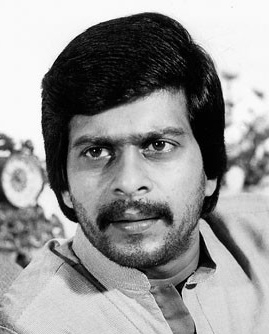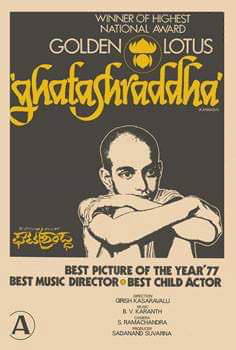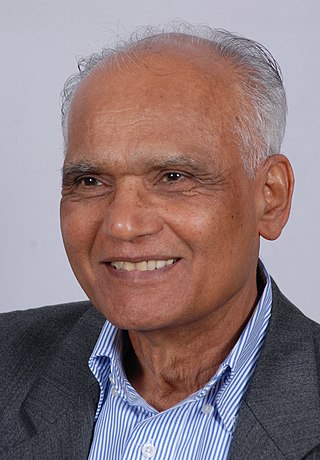Related Research Articles

Kannada cinema, also known as Sandalwood, or Chandanavana, is the segment of Indian cinema dedicated to the production of motion pictures in the Kannada language widely spoken in the state of Karnataka. The 1934 film Sati Sulochana directed by Y. V. Rao was the first talkie film in the Kannada language. It was also the first film starring Subbaiah Naidu and Tripuramba, and was the first motion picture screened in the erstwhile Mysore Kingdom. The film was produced by Chamanlal Doongaji, who in 1932 founded South India Movietone in Bangalore.

Girish Karnad was an Indian actor, film director, Kannada writer, playwright and a Jnanpith awardee, who predominantly worked in Kannada, Hindi, Tamil, Telugu, Malayalam and Marathi films. His rise as a playwright in the 1960s marked the coming of age of modern Indian playwriting in Kannada, just as Badal Sarkar did in Bengali, Vijay Tendulkar in Marathi, and Mohan Rakesh in Hindi. He was a recipient of the 1998 Jnanpith Award, the highest literary honour conferred in India.

Udupi Rajagopalacharya Ananthamurthy was an Indian contemporary writer and critic in the Kannada language. He was born in Thirtahalli Taluk and is considered one of the pioneers of the Navya movement. In 1994, he became the sixth Kannada writer to be honored with the Jnanpith Award, the highest literary honour conferred in India. In 1998, he received the Padma Bhushan award from the Government of India. He was the vice-chancellor of Mahatma Gandhi University in Kerala during the late 1980s. He was one of the finalists of Man Booker International Prize for the year 2013. He remained a fervent critic of nationalistic political parties until his death from kidney failure and cardiac arrest on 22 August 2014.

Babukodi Venkataramana Karanth widely known as B. V. Karanth was an Indian film director, playwright, actor, screenwriter, composer, and dramatist known for his works in the Kannada theatre, Kannada cinema, and Hindi cinema. One of the pioneers of the Parallel Cinema, Karanth was an alumnus of the National School of Drama (1962) and later, its Director. He received the Sangeet Natak Akademi Award (1976), six National Film Awards, and the civilian honor Padma Shri for his contributions towards the field of art.

Shankar Nagarakatte was an Indian actor, screenwriter, director, and producer known for his work in Kannada-language films and television. A popular cultural icon of Karnataka, Nag is often referred to as Karate King. He directed the teleserial Malgudi Days, based on novelist R. K. Narayan's short stories and acted in some episodes as well. He won two National Film Awards, four Karnataka State Film Awards and two Filmfare Award South.
Chitrapur Saraswats are a small Konkani-speaking community of Hindu Brahmins in India. They are traditionally found along the Kanara coast and call themselves Bhanaps in the Konkani language.

Tikkavarapu Pattabhirama Reddy was an Indian film screenwriter, producer, director, social activist, poet, and writer known for his pioneering works in Telugu cinema, and Kannada cinema.
Mulki is a panchayat town located at Mangalore taluk in Dakshina Kannada district in the Indian state of Karnataka. It is on the banks of Shambhavi River. It was earlier known as Moolikapur, turned to Mulki. A small town with people of diverse religions, it is 10 km north of Suratkal. Karnad is a locality within Mulki. Nearest railway station is Mulki railway station

Thaayi Saheba is an Indian Kannada language film released in 1997 directed by Girish Kasaravalli. The film was an adaptation of Kannada novel of same name written by Ranganath Shyamrao Lokapura.

Ghatashraaddha is a 1977 Indian Kannada language film directed by Girish Kasaravalli starring Meena Kuttappa, Narayana Bhat and Ajith Kumar in lead roles. It is based on a novella by eminent Kannada writer U. R. Ananthamurthy. The film was Girish Kasaravalli's first feature film as a director, and marked not only the arrival of a promising new filmmaker but also that of Kannada cinema in the India's 'New Cinema' horizon.
Taledanda is a 1990 Kannada-language play written by Girish Karnad, an eminent person in Kannada literature, about the rise of the radical protest and reform movement, Lingaytism, in 12th century Karnataka. He was awarded the Karnataka Sahitya Academy Award (1993) and the Sahitya Akademi Award in Kannada language for the play in 1994, and later awarded the Jnanpith Award for his literature work in 1998.

Santeshivara Lingannaiah Bhyrappa is an Indian novelist, philosopher and screenwriter who writes in Kannada. His work is popular in the state of Karnataka and he is widely regarded as one of modern India's popular novelists. His novels are unique in terms of theme, structure, and characterization. He has been among the top-selling authors in the Kannada language and his books have been translated into Hindi and Marathi which have also been sellers.

The 20th National Film Awards, presented by Ministry of Information and Broadcasting, India to felicitate the best of Indian Cinema released in the year 1972.

Channapatna Ramaswami Simha, better known as C. R. Simha, was an Indian actor, director, dramatist and playwright. He was best known for his work in Kannada films and for his work in stage shows. Starting his career in Prabhat Kalavidaru, a theatre group based in Bengaluru he acted in numerous Kannada plays which reached the cult status. He started his own theatre group called "Nataranga" in 1972 and directed many successful plays such as Kakana Kote, Thughlaq and Sankranthi.
Snehalatha Reddy was an Indian actress, producer and social activist known for her works in Kannada cinema, Kannada theatre, Telugu cinema, and Telugu theatre. She was arrested over her involvement in the Baroda dynamite case and imprisoned for over 8 months during the Emergency in India. She was the co-founder of the Madras Players in the 1960s, the amateur group that staged memorable productions like Ibsen's Peer Gynt, directed by Douglas Alger, besides Twelfth Night and Tennessee William's Night of the Iguana, directed by Peter Coe. Besides, she acted in, directed, or produced plays such as A View from the Bridge and The House of Bernarda Alba. In 2003, her husband Pattabhirama Reddy presented - In the Hour of God, a play based on Sri Aurobindo's classic Savitri, inspired by the mythical woman who defied death for love, which he dedicated to Snehalata Reddy.
Santha Shishunala Sharifa is a 1990 Indian Kannada biographical drama film directed and co-written by T. S. Nagabharana and produced by Srihari Khoday and Mahima Patel for Yajaman Enterprises. The story is based on the life of acclaimed saint poet Shishunala Sharif who wrote several moral poems striving towards social reformation. A collection of Sharif's poems are set to tunes by C. Ashwath, who also did the major playback singing. The soundtrack consisting of 16 poems was extremely popular upon release. The dialogues for this movie was written by Gopala Wajapayi, a well known theatre figure and translator of Bertolt Brecht's play The Caucasian Chalk Circle.

Madhva Brahmins, are Hindu Brahmin communities in India, who follow Sat Vaishnavism and Dvaita philosophy propounded by Madhvacharya. They are found mostly in the Indian states of Karnataka, Maharashtra, Goa, Tamil Nadu, Kerala, Telangana and Andhra Pradesh.

Girish Rao Hatwar, popularly known as Jogi, is a Kannada writer and journalist. Being one of the Kannada neo-literature writers, he has written short stories, novels and columns in many Kannada periodicals and daily newspapers. He has also written scripts for television serials, lyrics and screen play for movies. A journalist by profession, Jogi is currently a Magazine Editor of Kannada Prabha daily.
References
- 1 2 "18th National Film Awards" (PDF). Directorate of Film Festivals. p. 2. Archived (PDF) from the original on 26 February 2012. Retrieved 26 September 2011.
- 1 2 Kumar, G. S. (6 July 2014). "A sepia-tinted walk down 'Samskara' lane". The Times of India. Bangalore. Archived from the original on 9 April 2017. Retrieved 9 April 2017.
- 1 2 3 "End of a path-breaking journey". The Deccan Herald . 16 May 2006. Archived from the original on 29 September 2007. Retrieved 8 August 2007.
- ↑ "Directorate of Film Festival" (PDF). Archived from the original (PDF) on 8 July 2015. Retrieved 7 October 2014.
- ↑ S Kalidas and Rehmat Merchant. "Renaissance Man". Online Edition of the India Today, dated 1999-04-12. Living Media India Ltd. Archived from the original on 24 November 2010. Retrieved 8 August 2007.
- ↑ "35th National Film Festival" (PDF). Directorate of Film Festival. Archived from the original (PDF) on 21 July 2011. Retrieved 30 July 2011.
- ↑ Parvathi Menon. "The multi-faceted playwright". Frontline, Vol. 16, No. 3, Jan. 30-Feb. 12, 1999. The Hindu. Archived from the original on 30 September 2013. Retrieved 8 November 2016.
- 1 2 3 4 5 "A Film and its Censorship". The Indian Express. 3 January 1970. p. 10. Archived from the original on 14 July 2022. Retrieved 9 April 2017.
- 1 2 Chandra Holm. "Samskara". Online Webpage of OurKarnataka.com. Archived from the original on 27 August 2007. Retrieved 8 August 2007.
- ↑ Ananthamurthy, U. R., "How I wrote Samskara" in Boral, Rao, Rath: Samskara, a critical reader, Delhi, 2005
- ↑ Muralidhara Khajane (18 February 2005). "Fruits of labour". The Hindu . Chennai, India. Archived from the original on 28 February 2007. Retrieved 8 August 2007.
- ↑ Narasimham, M. L. (20 May 2005). "Spinning magic". The Hindu . Retrieved 9 April 2017.[ dead link ]